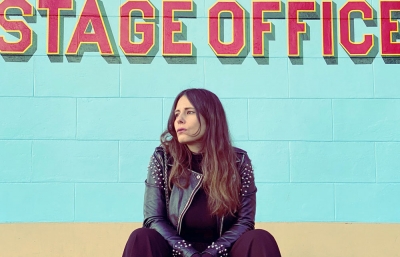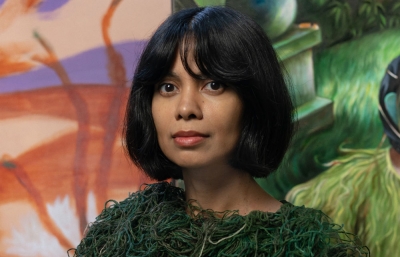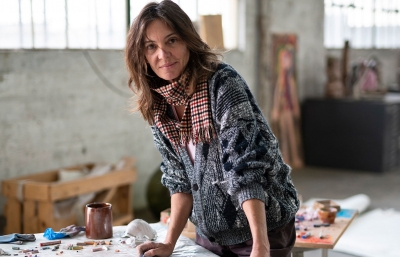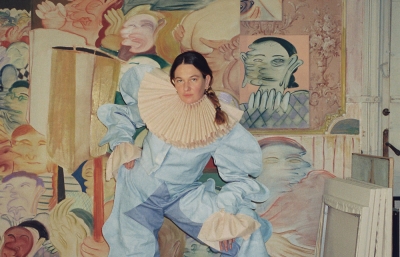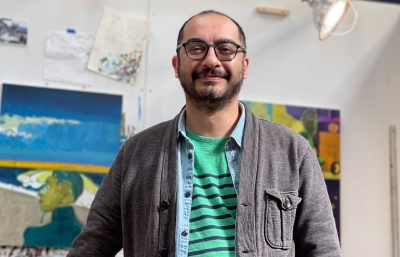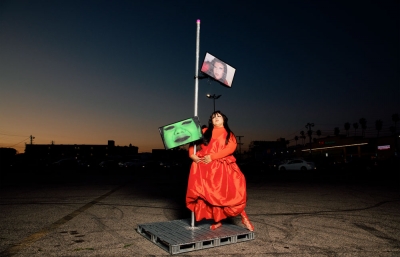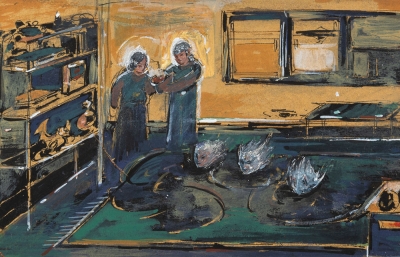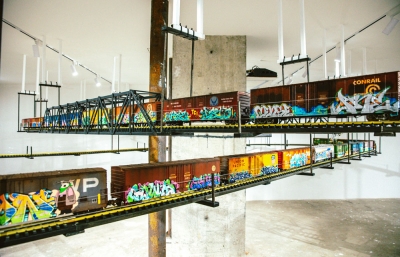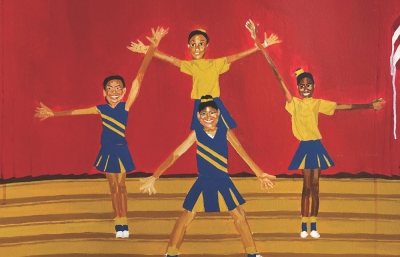The cover on a VHS copy of the 1997 movie "Nevada" shows a solitary woman wandering along a sand-swept freeway, framed by sagebrush and asphalt, a classic image of the area, largely desert and semi-arid.
The cover on a VHS copy of the 1997 movie Nevada shows a solitary woman wandering along a sand-swept freeway, framed by sagebrush and asphalt, a classic image of the area, largely desert and semi-arid. But the first European explorers of the region, the Spaniards, called it Nevada, which means snowy, because of the white capped mountains. And so, in many ways, it truly is the Silver State.

Timoth Conder, NIck Larsen and Omar Pierce, I Wonder If I Care As Much (Protagonist), 2015
The Great Basin formed as a result of the Pacific plate pulling away from the continental plate, the crust stretching as blocks broke loose and dropped to form mountain ranges and 90 basins (or valleys) that flowed inland and, in time, filled, teeming with rich sediment. The exhibit, Tilting the Basin, showcases this bounty, as over 30 artists who live and work in Nevada define the land. Opening in Reno at the Nevada Museum of Art and later in Las Vegas, it pours forth thanks to co-curators Joanne Northrup and Michele Quinn, respectively based North and South, who know their way and share clear visions of the road ahead.
Read the full feature in the September 2016 issue of Juxtapoz Magazine.
Gwynned Vitello: Joanne, coming from the San Jose Museum of Art and Santa Clara University, both identified with Silicon Valley, what attracted you to the Nevada Museum of Art, which is geographically associated with Lake Tahoe, ski resorts and cowboys? How have your viewpoints or expectations changed, and what do you bring from that to this show?
Joanne Northrup: As a curator, I respond to the community in which I am based. In Silicon Valley, my focus was on artists of the Pacific Rim, and the technology that pervades that region. I curated the first survey exhibitions of the work of Los Angeles-based digital animation artists Jennifer Steinkamp in 2006, and the New York based light sculptor Leo Villareal in 2010, which came to the Nevada Museum of Art after opening in San Jose. The city of Reno might be considered the “gateway to Burning Man” given the proximity of the Black Rock Desert where the event is held every year. Leo is arguably the most celebrated “art world” artist who shows his work at Burning Man in the context of his camp, Disorient. When we first began working on his survey exhibition, Leo and I bonded over the fact that both of us began attending Burning Man in the 1990s.
In some ways, it seemed like a natural progression that I would come to Nevada after having such a positive experience with Leo’s show at the Nevada Museum of Art. I was attracted by the leadership at the Museum, specifically by the fearless, ambitious director, David Walker, who’s from Los Angeles, where I had also lived and attended graduate school. I was also attracted by the intellectually curious staff and unorthodox ideas being produced by the Museum; it’s a place with drive and grit. Curiously, during the Great Recession, the Nevada Museum of Art doubled its operating budget. I thought to myself, “There must be something going on there ...” And I came to find out. Within two years, I had curated Late Harvest, an exhibition that juxtaposed cutting edge contemporary art made with taxidermy with traditional wildlife paintings from the nineteenth and twentieth century. Quite a change!
Being in Nevada has refocused my interests and priorities. My work on Tilting the Basin began with a challenge from David Walker—he asked me one day whether I could identify ten contemporary artists making accomplished work in Nevada. Michele Quinn has been a great partner in curating this exhibition because she has a deep understanding of the Las Vegas contemporary art scene. Yet we approached the selection with similar criteria, since we are both regularly exposed to the best international art through frequent travel to visit museums and galleries, and attend art fairs such as the Venice Biennale, Documenta and the like.
Michele, In your case, I’d imagine that moving from New York City back to our childhood home of Las Vegas must have involved a professional and personal kind of adjustment. Did you find a new appreciation for Vegas, after 11 years in the national epicenter of the art world? How did you seek out artists in this modern, relatively new city—only incorporated in 1911?
Michele Quinn: Moving back to Las Vegas was challenging but exciting on many levels. There was a definite “culture shock” from the New York art world, as there would have been no matter where I would have gone, as nothing compares to New York. But looking back, I can appreciate that there was a small but strong burgeoning art scene, with a close network of artists and people looking to support the arts and create something good. People were excited about what we were trying to do, bringing high level, internationally renowned artists to the cultural scene. Artists were naturally drawn to us, just by the nature of the work we were showing. Eventually, I started to hire many of them as art handlers and gallery assistants, as they were the best people to have in the gallery and explain the work being shown to the general public.
Many of these artists are in our exhibition, including David Ryan, Shawn Hummel, Brent Sommerhauser and Matthew Couper, so the relationships have remained strong over the years. I usually ask them who they think are the best artists in town, since artists are the best resources for other artists. However, the list of studio visits (28 in Las Vegas alone) for Tilting the Basin grew beyond those I already knew, and we were excited to see and learn about many new artists in the Las Vegas area that I had somehow not been introduced to yet.

David Ryan, Stack #5, 2014
David Ryan
Las Vegas and Reno are easily accessible, yet still remote suburbs of Los Angeles and San Francisco, respectively. This proximity provides permissive environments to make the art you want to see without the prohibitive costs-of-living those neighboring cities demand. In addition, there’s a groundswell of optimism surrounding the arts in Nevada. Perhaps it is the North/South romance brewing or merely the way scenes come to fruition, but Nevada feels like a community pushing for its artists, collectors, curators, thinkers and tastemakers to claim this point in time.

Galen Brown, Details of No Installation, 1988-1994
Galen Brown
When I returned to live in Nevada, I began to spend time kayaking at Washoe Lake, a way of quieting my mind and reconnecting with a more natural environment. After a few summers of morning paddles, I started to see brown and black volcanic rocks on the beach and thought that working with rocks in some way might help me to connect my art-making process closer to my life and Northern Nevada’s environment.

Justin Favela, The Valley of Mexico from the Stanta Isabel Mountain Range, after Jose Maria Velasco, 2016
Justin Favela
Home means Nevada. I feel very fortunate to live and work in Las Vegas, the place where I was born and raised. I get to make work and be around my family and friends, which inspires a lot of the work I do. The more I travel, the more interesting I find Las Vegas, a city built to attract people from across the globe, so no matter where I travel, I seem to see glimmers of hom

Katie Lewis, 6359, 8718, 11284, 4531, 9143, Thread Installation, 2016
Katie Lewis
Living in Nevada has a sense of openness or freedom for me. I think this is partly to do with the vastness of the landscape and also the rapidly changing community of Reno where things are not completely set in stone. This allows me to take risks and experiment without being afraid of failing. I also do not feel compelled to make work that fits into what might be considered trendy or hot in a large urban area. Living here allows me to be truer to the work I want to make.

Rachel Stiff, Behind Lone Mountain, 2015
Rachel Stiff
Space is what interests me most. Nevada has a lot to offer. From the outskirts of town, where I live, one can examine the composition of Las Vegas and its relationship with surrounding landforms. There are endless variations of color and light, depending on exact location and time of day. Through painting, I frame the modern West; exit ramps serve sunsets-to-go and mysterious bluffs quietly exhibit the beauty of perspective from the grocery store parking lot.

Brent Sommerhauser, Untitled, 2014
Brent Sommerhauser
An interesting part of living in Nevada is that it seems to be the equivalent of living in more than one city at a time. There are many different currents flowing, and if you can find the energy, you can hop over from one stream to the next one. Being able to find work in a variety of fields is critical when one dries up. I’ve worked as a stagehand, a set builder, a professor, a studio assistant, a coordinator, an art handler and an artist—in many cases, all at the same time! Similarly noteworthy is the scale on which things can be accomplished here, the overhanging notion that anything can be done, It’s tangential, but important that most of my gigs are behind-the-scenes, so I can see how many parts come together to create an ambitious whole.
----
Originally published in the September 2016 issue of Juxtapoz Magazine, available here.

